Gail’s Story
Honoring a Legacy: Inspiring Future Generations Through Aviation and Service
The Gail S. Halvorsen Aviation Education Foundation was founded to share Colonel Gail S. Halvorsen’s love of learning, aviation and his principles of “service before self, attitude, gratitude, and that little things add up to big things.”
Colonel Gail S. Halvorsen, known all over the world as The Berlin Candy Bomber served as a catalyst for what came to be known as “Operation Little Vittles.” His legacy has inspired generations of children to become pilots, teachers, and so much more, and has also inspired people everywhere to give back and to serve more in their communities.

Dreaming of Flying

One day at the Fence
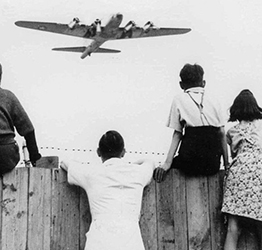
Food for Freedom
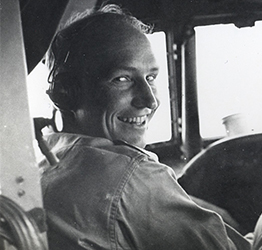
Airlift Impressions
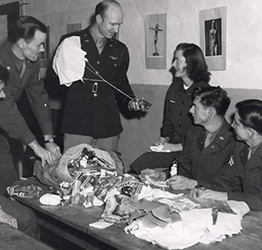
Moment to Movement
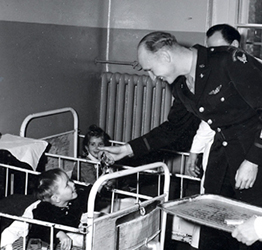
Service Before Self
Dreaming of Flying
Dreaming of flight, Halvorsen applied for and was accepted into a pilot-training program in Tremonton, Utah. The attack on Pearl Harbor prompted him to join the Army Air Corps, and he trained on fighters with the Royal Air Force.
In Gail’s own words:
“I began my life on small farms in Idaho and Utah. Things were peaceful. I received a flight scholarship for a private pilot license. I flew Civil Air Patrol missions. Then came Pearl Harbor and everything changed. I trained as a fighter pilot with the Royal Air Force then served as a transport pilot in the South Atlantic Theater of Operations.”
Gail’s Legacy of Service:
The Foundation continues Gail’s legacy of service with service opportunities in schools, communities and organizations throughout the valley. You can be a part of that legacy by volunteering for our programs here.
Berlin Airlift
“The Airlift was not just an Air Force operation. The Army and Navy were also heavily involved. The Navy had two top flight squadrons of R=5Ds (C-54s) and had the vital Sea Lift across the Atlantic. The Army had many roles but the greatest was moving everything on the ground. America was not alone. The British and French were partners.
“On that first flight to Berlin I was deep in thought. Hitler began this war of destruction. It had interrupted the orderly progress of my life. Now I was 27 years old. I should have had one or two children by now. Instead I wasn’t even engaged to be married. Several of my buddies had returned from the war to see their previously conceived child for the first time. Many did not return. They would not see their newborn child in this life. My close friend, Conrad Stefen from Tremonton, Utah was still missing. I had interested him in being a pilot by flying him in my J-3 Cub before the war. Maybe his remains were somewhere under the flight path I had flown that very day, on my way from Frankfurt to Berlin. He had been shot down three years before in his P-47 Thunderbolt.
“We had just left the security and comfort of life in America. We were beginning to get our lives back to normal after the war. Now, here we were flying night and day in all kinds of weather; living in tents and tar paper shacks that had housed Hitler’s Displaced Persons work gangs. As for me my bed was in the attic of a farmer’s old barn in Zepplinheim! We had left for Germany so fast I had to drive the first new car of my life under the trees in Mobile Alabama, put the keys in my pocket, look back once and leave. I would never see that new, red, four door Chevy again.”
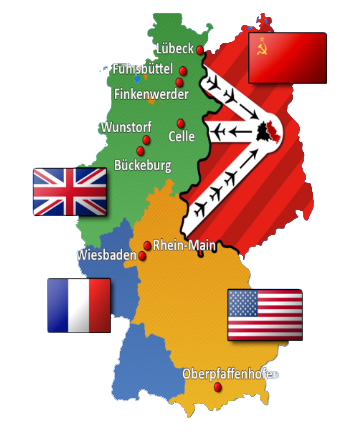
Impressions of a Berlin Airlift Pilot
Impressions of a Berlin Airlift Pilot (Written March 18, 2008):
“When World War II ended, the last thing I ever thought might happen was that in 1948 I would be in Europe, flying day and night to Berlin. Flights would be in thunderstorms, fog, ice and snow to feed the former enemy. On my first trip to Berlin the flattened ruins of the once proud and sophisticated capital looked like a moonscape as the wreckage passed beneath the wings of my flour laden C-54 Skymaster. Below my wings were splintered buildings, gaping to the sky with open roofs. Their once stately walls were broken into individual bricks and scattered in the streets and across lots now vacant; lots that once held architecturally classic buildings. It was a signature of war evident in countries around the world.”
Why was the Berlin Airlift so important?
The Soviet Union’s blockade of West Berlin was the opening salvo in the Cold War. America and her allies stepped up and made it a decisive victory. It was a daunting task to supply the food and other needs for so many civilians for an unknown length of time. Without firing a shot, the Soviet plan to hold West Berlin hostage was defeated.
Food for Freedom
“One of my fellow Airlift pilots had bombed Berlin during the war. I asked him how he felt about flying day and night on behalf of the enemy, the very ones who did their best to kill him as he flew over Berlin in 1944. He hesitated a moment, shuffling his feet and then said, ‘It feels a lot better to feed them than it does to kill ’em.’”
Food for Freedom:
West Berliners told Col. Halvorsen and other pilots, “When the weather gets so bad you can’t land don’t worry about us. We can get by on little food but if we lose our freedom we may never get it back.”
The principle of freedom was more important than the pleasure of enough flour. “Just don’t give up on us,” they asked. The Soviets had offered the Berliners food rations but they would not capitulate.
One day at the Fence
“One day in July 1948 I met 30 kids at the barbed wire fence at Tempelhof in Berlin. They were so excited. All I had was two sticks of gum. I broke them in two and passed them through the barbed wire. The result was unbelievable. Those with the gum tore off strips of the wrapper and gave them to the others. Those with the strips put them to their noses and smelled the tiny fragrance. The expression of pleasure was unmeasurable.”
“I was so moved by what I saw and their incredible restraint that I promised them I would drop enough gum for each of them the next day as I came over their heads to land. They would know my plane because I would wiggle the wings as I came over the airport.”
“When I got back to base I attached gum and even chocolate bars to three handkerchief parachutes. We wiggled the wings and delivered the goods the next day. What a jubilant celebration.”
From Moment to Movement
Col. Halvorsen enlisted the help of others and the candy drops grew. Soon letters began coming in.
In Gail’s own words:
“A little girl, Mercedes, wrote that I scared her chickens as I flew in to land but it was OK if I dropped the goodies where the white chickens were. ‘When you see the white chickens, drop it there. I don’t care if it scares them.’ I couldn’t find her chickens so I mailed her chocolate and gum through the Berlin mail.
“Twenty two years later, 1970, I was assigned as the commander of Tempelhof. One letter kept asking us to come to dinner. In 1972 we accepted. The lady of the house handed me a letter dated November 1948. It said, ‘Dear Mercedes I can’t find your chickens. I hope this is OK. Your Chocolate Uncle.’ I had attached a box of candy and gum. The lady said, ‘I am Mercedes step over here and I will show you where the chickens were.’”
Service Before Self
In Gail’s own words:
“My experience in the Airlift taught me that gratitude, hope, and service before self can bring happiness to the soul when the opposite brings despair. Because not one of 30 children begged for chocolate, thousands of children in Berlin received over 20 tons of chocolate, gum and other goodies, delivered on the ground, or dropped from C-54 Skymaster aircraft over a 14 month period.”
Gail’s Legacy of Service:
The airlift taught Gail to look outside himself and find ways to bring hope to others. The Foundation continues that legacy by bringing his principles of gratitude and service before self to schools and community organizations throughout the valley, along with giving students opportunities in STEM and aviation education.
